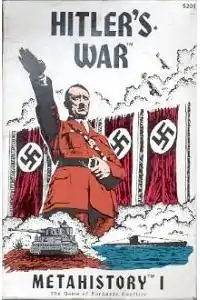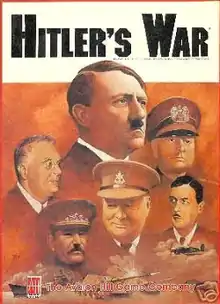Hitler's War (game)
Hitler's War is a strategic level World War II war game for 2 or 3 players, first published by Metagaming Concepts in 1981, and then by Avalon Hill in 1984.
 Metagaming Concepts edition, 1981 | |
| Publisher(s) | Metagaming Concepts Avalon Hill |
|---|---|
| Publication date | 1981 |
| Players | 2-3 |
| Skill(s) required | Strategy |

Description
Hitler's War is a simulation of the Second World War in Europe.[1] The game is divided into three scenarios, each of which becomes more complex with the addition of new rules:
- Operation Barbarossa: This simulation for two players covers the period of war between Germany and the USSR after Germany's invasion in 1941. It is designed to introduce the players to the game's combat and movement system.[2]
- The Fall of Germany: This scenario for two or three players is linked to the end of the "Operation Barbarossa" scenario, and in addition to the Eastern Front versus the USSR, adds the Western Front opened by the Allies on D-Day. More complex rules are introduced, including sea movement, amphibious assaults, supply lines, and forts. As an option, the Allies' Eastern and Western forces can be divided between two players, turning this into a three-player game.[2]
- Campaign game: This simulates the entire war, 1939–1945, in four-month turns, and can be played by either two or three players. The basic campaign uses all of the rules introduced in the first two scenarios. The advanced campaign also adds complexity with the addition of submarine warfare and strategic bombing, counter-measures against both, neutral countries, tactical air power, paratroops, naval combat, and surrender. A further option is to include military research and development, which can lead to new weapons such as the V-1 and V-2 rockets, and even atomic bombs.[2]
Components
Both the Metagaming Concepts and Avalon Hill boxed sets have the following components:[2]
- 360 die-cut cardboard counters
- map (a 17" x 22" paper map in the Metagaming Concepts version, a 16" x 22" cardboard map in the Avalon Hill version)
- 3 player aid sheets
- 24-page rule book
- a six-sided die
Movement
Each side is given 12 army group counters that can hold up to 10 strength points. These counters can be moved an unlimited distance between controlled hexes, and strength points can be freely shuffled between army groups.[2]
Combat
Once adjacent to an enemy army, the attacker declares which of their armies will attack. The defender then fires first, totalling the defending army's Strength Points versus the attacker's Strength Points and rolling a die on the Combat Resolution Table (CRT), indicating how many Strength Points the attacker loses. Once that is resolved, the attacker does the same thing. Next, the attacker may attempt to move into the defender's hex, success being dependent on the defender's remaining Strength Points and the attacker's number of mechanized units. If the attacker is successful in overcoming the defender, the same attacking army group may continue to attempt to advance in the same turn, and in blitzkrieg style, can repeatedly attack and advance as long as each attack is successful.[2]
Industrial units
Each area of the map has a certain number of Industrial Units (IUs). Once movement and combat have been completed, each side adds up how many IUs it controls, which then determines each side's budget for purchasing new Strength Points, repairing IUs damaged by conquest, and using them as a supply source.[2]
Victory conditions
In a two-player campaign game, the Allies win if Germany is defeated on or before April 1945. In a three-player game, the winning side is determined by the ratio of IUs owned by each player when Germany surrenders or by the summer of 1945.[2]
Playing time
Although the box lists the playing time as 1½ to 5 hours, reviewer Ken Rolston estimated that the full campaign game with three players would take 5–6 hours with experienced players.[2]
Publication history
Hitler's War was designed by Keith Gross, with graphics by Norman Royal, Trace Hallowell, and Jeff Boobar, and was published by Metagaming Concepts in 1981 as the first in their "Metahistory" series of games. In a departure from Metagaming's previous microgame/pocket game releases in small flat boxes or ziplock bags with paper sheets of counters, Hitler's War was a full-sized boxed set, with die-cut cardboard counters.[2]
Metagaming Concepts subsequently published two more games in the Metahistory series of boxed sets in 1981: The Trojan War, and Command at Sea.[3]
Following the demise of Metagaming Concepts in 1983, Avalon Hill bought the rights to Hitler's War and Stellar Conquest, republishing both of them in 1984.[3]
Reception
In the May 1982 edition of Dragon (Issue #61), Tony Watson thought Metagaming Concept's new large boxed set format "marks an important improvement quality for this company's products." He found the rulebook was "amply illlustrated and remarkably free of glitches, typos and misspellings." However, he criticized the decision to print important charts on the back of the rulebook, "which can cause considerable wear and tear on the booklet after a short bout of page-flipping." Watson found the positioning and movement rules "rather innovative." Although he found the first two scenarios and the basic campaign good, "the advanced campaign game adds the chrome and options that make a good game into an excellent one." Comparing this game to Avalon Hill's Third Reich, Watson thought that "Hitler’s War treats strategic warfare against enemy production in a more interesting manner. I found the production rules in Hitler’s War, including the technology section and the geographically based IUs (as compared to the more abstract Basic Resource Points used in Third Reich), to be more challenging." He concluded, "For gaming enthusiasts with any interest in World War II and/or grand strategic conflict, Hitler’s War is highly recommended."[2]
References
- "Hitler's War (1981)". BoardGameGeek. Retrieved 2020-12-30.
- Watson, Tony (May 1982). "Hitler's War puts European theater onto a small stage". Dragon. No. 61. TSR, Inc. pp. 71–72.
- "Metagaming Game Index and Descriptions". brainiac.com. Retrieved 2020-12-30.
See also
- Hitler's War - 1977 history book by David Irving
External links
- Hitler's War at BoardGameGeek
- Hitler's War Wargame Academy page on the Avalon Hill game
- Hitler's War for Windows Fan-made free computer game version of the board game